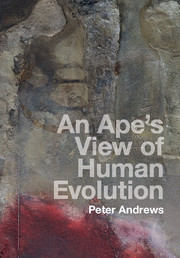Book contents
- Frontmatter
- Contents
- Preface
- 1 How can we recognize common ancestors?
- Part I Apes: their morphology and behaviour
- PART II Environments and palaeoenvironments
- Part III Review of fossil apes
- 7 The view from the early Miocene
- 8 The environment in the early Miocene
- 9 The view from the middle Miocene
- 10 Specialized apes from the middle Miocene
- 11 The environment during the middle Miocene
- 12 A second view from Europe
- 13 The environment in Europe
- 14 Late Miocene to Pleistocene apes
- 15 Apes, hominins and environment in the late Miocene
- Part IV Last common ancestor
- References and further reading
- Index
- References
10 - Specialized apes from the middle Miocene
from Part III - Review of fossil apes
Published online by Cambridge University Press: 05 January 2016
- Frontmatter
- Contents
- Preface
- 1 How can we recognize common ancestors?
- Part I Apes: their morphology and behaviour
- PART II Environments and palaeoenvironments
- Part III Review of fossil apes
- 7 The view from the early Miocene
- 8 The environment in the early Miocene
- 9 The view from the middle Miocene
- 10 Specialized apes from the middle Miocene
- 11 The environment during the middle Miocene
- 12 A second view from Europe
- 13 The environment in Europe
- 14 Late Miocene to Pleistocene apes
- 15 Apes, hominins and environment in the late Miocene
- Part IV Last common ancestor
- References and further reading
- Index
- References
Summary
Living at the same time as the afropithecines was another group of fossil apes, the kenyapithecines. They are much less abundant in the fossil record and come from just two sites, Fort Ternan in Africa and Paşalar again in Turkey. The Turkish site is one of the very few sites in Europe and Asia that has two hominid species apparently coexisting, although it will be seen in the next chapter that although they were found together in the same fossil site, there is compelling evidence that they did not live together in the same environment. At least two fossil apes are also present in the Fort Ternan deposits, with a proconsulid apparently coexisting with the kenyapithecine, but again there is good evidence that they were not living together in the same environment but were transported to the site from different places (see Chapter 11).
The upper jaw of Kenyapithecus wickeri from Fort Ternan was first described in 1962 by Louis Leakey, who saw it as a fossil ape more advanced towards the human condition than other fossil apes. Elwyn Simons and David Pilbeam also recognized this, and in their 1965 synthesis they combined it with the Indian genus Ramapithecus as a putative human ancestor. For many years Ramapithecus wickeri in Africa and Ramapithecus punjabicus in India and Pakistan enjoyed a certain notoriety as the earliest evidence for human origins, and they were cited in all the textbooks of that period. Ramapithecus wickeri, however, did not long enjoy its position, for while I was working on my PhD in Nairobi I managed to get a look at a small mandible from Fort Ternan that for years had been locked away in Louis Leakey's safe. Louis had said for years that he had a specimen of dryopithecine from Fort Ternan that was like the fossil apes from Europe, but he kept it locked away and would not let anyone see it. One day when he was going off on one of his many trips overseas, he lent me the key to his safe because he wanted me to look at some other fossils that he kept there, and I took advantage of the privilege to take out the fragment of jaw and examine it.
- Type
- Chapter
- Information
- An Ape's View of Human Evolution , pp. 161 - 168Publisher: Cambridge University PressPrint publication year: 2016



